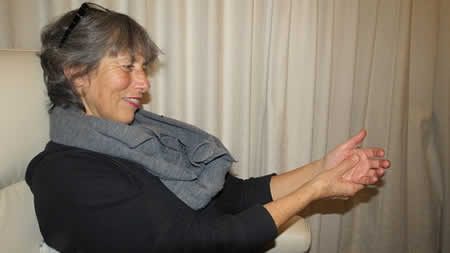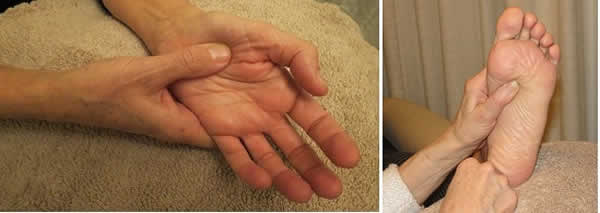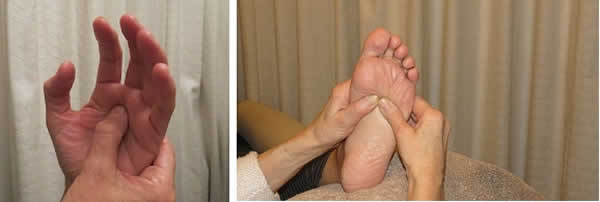Positive Health Online
Your Country

Reflexology can Help Sleep Issues
listed in reflexology, originally published in issue 220 - February 2015
Reflexology has always been considered to be a particularly relaxing and pleasant therapy as well as being very therapeutic in supporting specific conditions. Many reflexologists often specialize in techniques to bring about a deep relaxing night’s sleep or to help counteract insomnia issues. 25 years ago I experienced my first reflexology session and I felt very relaxed, yet energized. I also went on to have one of the best night’s sleep I had experienced for years! Once qualified as a reflexologist, I began to think about how I could develop specific techniques to help people sleep better and for longer and I devised the technique called Diaphragm Rocking. Lack of sleep has serious effects on our brain's ability to function and many people sleep very lightly during restless nights, which can impair cognitive function the next day, make concentration more difficult and shorten the attention span. There is no definitive length of time for sleep but the general consensus is that at least six hours of deep, quality sleep is essential for general well-being with the average person requiring just under 8 hours sleep.

Diaphragm Rocking in a relaxed position
There are many documented cases where lack of sleep had a devastating effect on decision-making which resulted in disastrous consequences. For example, the ill-fated Challenger space shuttle was launched in January 1985 following a 2 ½ hour conference call between NASA officials and executives from the company who made the rocket boosters, to discuss a possible fault. All seven astronauts on board were killed and the subsequent investigation concluded that poor decision-making was a key factor in the tragedy. It transpired that two of the NASA managers had been awake for 23 hours and had slept for no more than three hours the previous day.[1] Continued lack of sufficient sleep severely affects the part of the brain that controls language, memory, planning and sense of time and can result in it practically shutting down.
Many reflexologists visit residential nursing homes for older people and touch is a potent force in nearly all therapies. For some isolated or lonely older people, the gentle relaxing sensation that reflexology achieves is the one time they can be treated holistically as the whole body is stimulated each time and all ailments, large or small, can be addressed. Many persons, especially older people, are on a difficult and unproductive cycle of sleeping poorly at night which results in them dozing on and off all day because they are tired. This unsatisfactory state of living results in them often becoming too fatigued to participate in activities during the day, and life can become very boring and rather unfulfilled. Reflexology can help the body to relax and respond by releasing chemicals and brain signals to slow down muscles and organs and increase blood flow to the brain. This can lower the production of stress hormones like adrenaline and may also lower blood pressure.[2] I have run Sleep Seminars at the St Monica Trust,[3] Bristol for older residents and teach them gentle reflexology hand techniques to help them get to sleep at night or return to sleep. Two residents recently told me that this has helped to “buy them more time” in the day .i.e. they sleep better at night and are therefore not so tired in the day. This positive outcome has consequently transformed their afternoons which were formerly spent dozing, into times of creative activity. The gentle reflexology techniques described below are also beneficial for stress relief.
Important Practical Questions to Ask when Offering Help with Sleep Issues
A few years ago I worked for several weeks with a professional athlete who was having problems sleeping. I relaxed him generally with foot reflexology and eased tension in his lumbar spine. I also taught him self-help reflexology exercises on his hands to apply prior to bedtime and these made a moderate difference to his quality of sleep. It was only when I belatedly thought to ask him a very simple question, regarding the amount of daylight in his room, did his insomnia improve considerably. He had recently moved apartments and was sleeping in a bedroom with unlined curtains which meant the summer light came into the room very early through the thin cloth. He ordered blackout blinds and his problem was immediately solved. Reflexology was helpful but secondary to the main cause of his problem! The combination of applying simple detective work to the client’s physical situation, coupled with gentle reflexology techniques can make a tremendous difference to years of interrupted and shallow sleep. Once the physical issues have been dealt with, the body responds extremely well to the skilled reflexologist working spine, adrenal, neck and shoulder reflexes on the hands and feet.
- Most people are very aware that certain types of food, such as coffee, chocolate, cheese, can have a disruptive effect on sleep and these can be easily avoided. Sometimes it is helpful to suggest that a person cuts back on liquid in the evenings as they can find it very hard to go back to sleep in the middle of the night if they have to get up to go to the toilet;
- Is also useful to ensure that the bed is as comfortable as possible, with no hard springs or indentations. Some beds are very old, too hard or too soft and this can have a very detrimental effect on posture as well as quality of sleep and, if possible, changes should be made. Likewise, pillows can be too hard, too soft or too high;
- I treated one client for insomnia; she gained a much better night’s sleep once she replaced her feather pillow with a synthetic hyper-allergenic pillow that was ergonomically designed to support her neck.
|
Research into Prolonged Sleep Deprivation Research from Warwick Medical School published in 2011 in the European Heart Journal showed that prolonged sleep deprivation and disrupted sleep patterns can have long-term, serious health implications. The findings linked lack of sleep to some strokes, heart attacks and cardiovascular disorders which can often result in early death. Professor Francesco Cappuccio from the University of Warwick Medical School, explained: "If you sleep less than six hours per night and have disturbed sleep you stand a 48 per cent greater chance of developing or dying from heart disease and a 15 per cent greater chance of developing or dying of a stroke”. "The trend for late nights and early mornings is actually a ticking time bomb for our health so you need to act now to reduce your risk of developing these life-threatening conditions." Professor Cappuccio and co-author Dr Michelle Miller, from the University of Warwick, conducted the research programme which followed up evidence from 7 to 25 years from more than 470,000 participants from eight countries including Japan, USA, Sweden and UK. Dr Miller explained further: "Chronic short sleep produces hormones and chemicals in the body which increase the risk of developing heart disease and strokes, and other conditions like high blood pressure”.[4] |
Sleep and Relaxation Issues
The Diaphragm Rocking technique I have devised for the feet[5] and hands[6] is often the self-help key to alleviate insomnia. You can use the rocking movement alone with no other reflexology technique for up to two minutes per hand on or you can develop a set of moves that can target various parts of the body to help general relaxation. You can work your own feet or hands in between professional reflexology sessions or when you just need some self-help treatment. These simple instructions can also enable family and friends to work on each other.[7]
Techniques for Releasing Stress, Aiding Sleep and Relaxation Moves to Ease Musculoskeletal Tension Always repeat the technique on the other foot or hand.

Working Thumb Neck and Big Toe Neck Reflexes
- Work round the neck reflexes on the base and sides of the thumbs or toes by pinching gently and pressing the sides of the toe or thumb for approximately 15 seconds.

Working the Hand and Foot Spinal Reflexes
- Work up and down the spinal reflexes with your finger or thumb, following the side of the thumb or big toe to the wrist or ankle 3-4 times.

Adrenal Palm and Foot Reflexes
- Gently stimulate and press the adrenal reflex on the palm or sole for a maximum of 30 seconds.

Diaphragm Rocking on the Hand and Foot
- Apply Diaphragm Rocking: 10-20 rocks per hand (or foot if applied by someone else) before sleep and, if you wake up in the night, repeat the procedure as often as necessary. For hands: place you thumb in a stationery position on the palm as indicated and gently rock your fingers back and forward. For the feet: place your fingers on the top of the foot and press you thumbs as shown on the plantar and gently rock the foot backwards and forwards.
References
1. US National Library of Medicine National Institutes of Health www.ncbi.nlm.nih.gov Feb 1988; Catastrophes, Sleep, and Public Policy: Consensus Report Merrill M. Mitler, Mary A. Carskadon, Charles A. Czeisler, William C. Dement, David F. Dinges, and R. Curtis Graeber
2. The Association of Reflexologists www.aor.org.uk
3. St Monica Trust: residential care facility. Bristol www.stmonicatrust.org.uk
4. Journal Reference: F. P. Cappuccio, D. Cooper, L. D'Elia, P. Strazzullo, M. A. Miller. Sleep duration predicts cardiovascular outcomes: a systematic review and meta-analysis of prospective studies. European Heart Journal, 2011;
5. Booth, Lynne. Vertical Reflexology. Publ Piatkus Books, London. ISBN: 0-7499-2132-3 2000
6. Booth, Lynne. Vertical Reflexology for Hands. Publ Piatkus Books, London.
ISBN: 0-7499-2319-9 2003
7. Sleep and Relaxation video instructions Booth VRT website www.boothvrt.com
Comments:
-
No Article Comments available